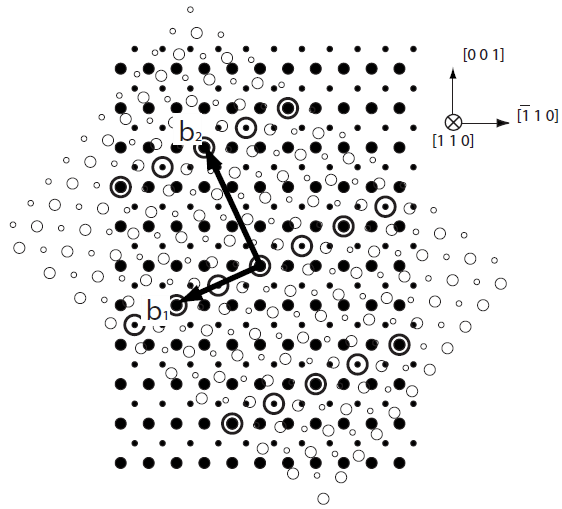=================================================================================
Table 4738 lists examples of CSL (coincident site lattice) translation vectors and angles of
misorientation (θ) at Σ11 <110> FCC tilt grain and twin boundaries. Figure 4738 shows the Σ11 CSL produced by rotation of two (black and white) FCC crystals. The density of the coincident sites is 1/11 so that it is a Σ11 boundary. The CSL translation vectors in the (110) plane are  and and  , where the Miller indices are given relative to the black lattice and , where the Miller indices are given relative to the black lattice and  . An arbitrary Σ11 [110] tilt grain boundary (GB) can be obtained by aligning the GB plane parallel to a chosen CSL plane in the [110] direction and discarding white sites on one side and black sites on the other side of the plane. The choice of these CSL planes as boundary planes produces two well-known symmetrical tilt GBs: Σ11 . An arbitrary Σ11 [110] tilt grain boundary (GB) can be obtained by aligning the GB plane parallel to a chosen CSL plane in the [110] direction and discarding white sites on one side and black sites on the other side of the plane. The choice of these CSL planes as boundary planes produces two well-known symmetrical tilt GBs: Σ11 [110] and Σ11 [110] and Σ11  [110], respectively. [110], respectively.

Figure 4738. Σ11 lattice misorientation
viewed along the [110] direction [1].
Table 4738. Examples of CSL (coincident site lattice) translation vectors and angles of
misorientation (θ) at Σ11 <110> FCC tilt grain and twin boundaries.
| CSL translation vectors |
Angle of misorientation (θ) |
|
|
|
50.48°
|
|
|
 / / |
50.48°
|
|
|
[1] J. A. Brown and Y. Mishin, Dissociation and faceting of asymmetrical tilt grain boundaries: Molecular dynamics
simulations of copper, Phys. Rev. B 76, 134118 (2007). |
